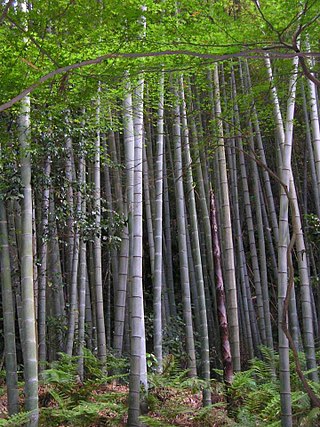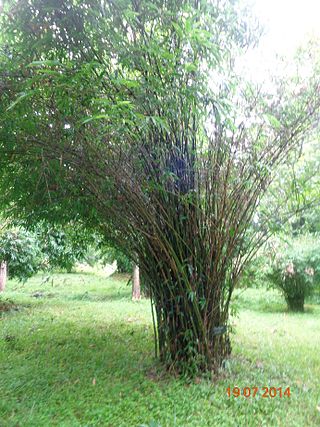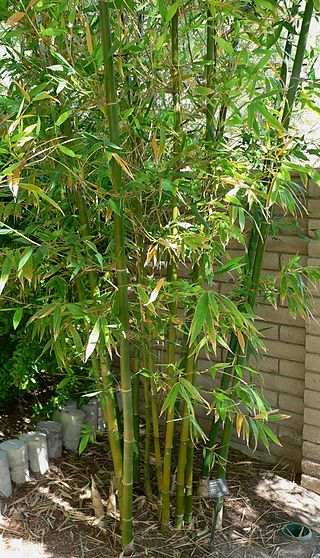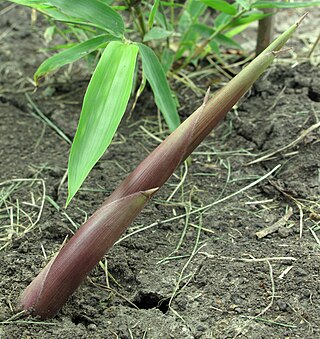
Bamboos are a diverse group of mostly evergreen perennial flowering plants making up the subfamily Bambusoideae of the grass family Poaceae. Giant bamboos are the largest members of the grass family, in the case of Dendrocalamus sinicus individual culms reaching a length of 46 meters, up to 36 centimeters in thickness and a weight of up to 450 kilograms. The internodes of bamboos can also be of great length. Kinabaluchloa wrayi has internodes up to 2.5 meters in length. and Arthrostylidium schomburgkii with lower internodes up to 5 meters in length, exceeded in length only by papyrus. By contrast, the culms of the tiny bamboo Raddiella vanessiae of the savannas of French Guiana are only 10–20 millimeters in length by about two millimeters in width. The origin of the word "bamboo" is uncertain, but it probably comes from the Dutch or Portuguese language, which originally borrowed it from Malay or Kannada.

Indocalamus is a genus of about 35 species of flowering plants in the grass family (Poaceae), native to China, Vietnam and Japan. They are quite small evergreen bamboos normally up to 2 m (6.6 ft) in height, initially forming clumps and then spreading to form larger thickets. They have thick, glossy leaves. Ruo leaves use to wrap foods like rice during dragon boat festival, originate in fujian refer to Indocalamus longiauritusoriginally but now are nonspecific to just about any leaf wrap.
Neomicrocalamus is an Asian genus of bamboo in the grass family.

Acidosasa is a genus of East Asian bamboo in the grass family.

Himalayacalamus is an Asian genus of mountain clumping bamboo in the grass family. Species members are found growing at lower altitudes of the Himalaya in Bhutan, Tibet, India, and Nepal.

Fargesia is a genus of flowering plants in the grass family. These bamboos are native primarily to China, with a few species in Vietnam and in the eastern Himalayas. Some species are cultivated as ornamentals, with common names including umbrella bamboo and fountain bamboo.
Gaoligongshania megalothyrsa is a species of small, bushy mountain bamboo, in the monotypic genus Gaoligongshania. Like Ferrocalamus, this genus is found only in Yunnan Province of China, and near the Myanmar border, at an altitude of 1,600 to 2,200 m. It is named after the Gaoligong Mountains, where it is endemic.

Phyllostachys aureosulcata, the yellow groove bamboo, is a species of bamboo native to the Zhejiang Province of China. It is a running bamboo with a distinctive yellow stripe in the culm groove that is often grown as an ornamental.

Bambusa vulgaris, common bamboo, is an open-clump type bamboo species. It is native to Indochina and to the province of Yunnan in southern China, but it has been widely cultivated in many other places and has become naturalized in several regions. Among bamboo species, it is one of the largest and most easily recognized.

Bambusa tulda, or Indian timber bamboo, is considered to be one of the most useful of bamboo species. It is native to the Indian subcontinent, Indochina, Tibet, and Yunnan, and naturalized in Iraq, Puerto Rico, and parts of South America.

Oldeania alpina, the African alpine bamboo, is a perennial bamboo of the family Poaceae and the genus Yushania. It can be found growing in dense but not large stands on the mountains and volcanoes surrounding the East African Rift between 2,500 meters and 3,300 meters elevation.

Bambusa oldhamii, known as giant timber bamboo or Oldham's bamboo, is a large species of bamboo. It is the most common and widely grown bamboo in the United States and has been introduced into cultivation around the world. It is densely foliated, growing up to 20 metres tall in good conditions, and can have a diameter of up to 10 centimetres.

Bambusa lako, known as Timor black bamboo, is a large species of bamboo originating from the island of Timor; its black culms may reach 21 m (69 ft) in height. A 2000 molecular study places it as closely related to the similar Indonesian species Gigantochloa atroviolacea, from which it was separated in 1997; it may soon be placed in that genus. Bambusa lako can only be grown in climates that are mostly frost-free.

Phyllostachys parvifolia is a running bamboo with thick culms that grow tall for a bamboo that endures cold weather.

Dendrocalamus strictus is a bamboo species belonging to the Dendrocalamus genus. The culms (stems) are often solid. Common names include male bamboo, solid bamboo, and Calcutta bamboo.
Bashania is a genus of East Asian bamboo in the grass family, native to China and Vietnam.
- Bashania abietinaT.P.Yi & L.Yang – Sichuan
- Bashania fansipanensisT.Q.Nguyen – Vietnam
- Bashania fargesii(E.G.Camus) Keng f. & T.P.Yi – Gansu, Hubei, Shaanxi, Sichuan
- Bashania qingchengshanensisKeng f. & T.P.Yi – Sichuan
Sasamorpha is a genus of East Asian bamboo in the grass family.
- Sasamorpha borealis(Hack.) Nakai – Korea, Japan, Sakhalin
- Sasamorpha hubeiensisC.H.Hu – Hubei, Jiangxi
- Sasamorpha oshidensis(Makino & Uchida) Nakai – Japan
- Sasamorpha qingyuanensisC.H.Hu – Zhejiang
- Sasamorpha sinica(Keng) Koidz. – Anhui, Zhejiang

Indocalamus tessellatus, the large-leaved bamboo, is a species of flowering plant in the grass family Poaceae, native to China. A medium-sized, hardy evergreen bamboo growing to 2 m (6.6 ft), it forms a clump of broad leaves 60 cm (24 in) long and up to 10 cm (3.9 in) wide – the broadest of any bamboo – which cause the slender cane to bend under their weight. Though hardy down to −15 °C (5 °F) and able to survive conditions in most of the UK, it prefers a sheltered site in semi-shade with moist, rich soil. Given the best conditions possible, it will eventually form large thickets or groves, but can be kept in a large container. In cultivation in the UK it has gained the Royal Horticultural Society's Award of Garden Merit.

Bambusa textilis, also known as slender bamboo, clumping bamboo and weaver's bamboo, is a species of bamboo in the Poaceae (grasses) family that is native to China. The subspecies var. gracilis is heavily cultivated in Australia.
Yi-Li Keng was a Chinese botanist, specializing in the study of grasses, particularly the tribe Triticeae of the Poaceae.














